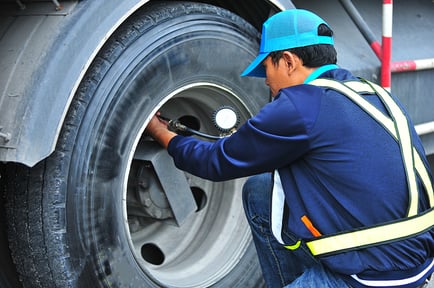
Maintaining proper tire inflation pressure is essential for safe and efficient driving, regardless of the season. However, there are specific reasons why insufficient tire inflation pressure during the wintertime can lead to more serious issues. Engaging and educating drivers, providing them with the necessary tools, and establishing a maintenance plan can go a long way in preventing tire-related issues during the winter and throughout the year.
Here are some common causes of insufficient tire inflation pressure for drivers to monitor:

-
Reduced Traction: In cold weather, tire pressure naturally decreases due to the contraction of air inside the tire. Underinflated tires have less contact with the road surface, leading to reduced traction. This can be particularly problematic in winter when road surfaces are often slippery due to ice and snow.
-
Decreased Fuel Efficiency: Underinflated tires can increase rolling resistance, requiring your truck to use more energy (and thus more fuel) to move. In winter, when fuel efficiency is already reduced due to colder temperatures and increased use of heating systems, this can lead to higher fuel costs.
-
Uneven Wear: Underinflated tires tend to wear unevenly, with the edges of the tire experiencing more stress and wear than the center. This uneven wear can result in the need for premature tire replacement, which can be costly.
-
Handling and Control Issues: Proper tire pressure is crucial for maintaining optimal handling and control of your vehicle. Inadequate pressure can lead to decreased stability and responsiveness, which can be dangerous in winter driving conditions.
-
Risk of Blowouts: Running on underinflated tires increases the risk of tire blowouts, which can be particularly hazardous in winter when road conditions are challenging.
-
Tire Pressure and Temperature: Tire pressure is affected by temperature changes. It's important to regularly check and adjust tire pressures to ensure they are within the manufacturer's recommended range. Fluctuations in temperature can lead to under-inflated or over-inflated tires, which can impact safety and fuel efficiency.
-
Tire Pressure and Moisture: Moisture build-up in the valve stem can freeze in cold temperatures, leading to air loss and reduced tire pressure. Regularly checking and maintaining proper tire pressure can help prevent this issue.
- Tire Depth: Checking tire tread depth is essential to ensure the tires have enough grip, especially in wet or icy conditions. Tires with insufficient tread depth are more prone to skidding and reduced traction.
Positioning your fleet's tire program for success going into and coming out of the winter months sounds complicated, but it's simpler than you think.

Here are some valuable tips to ensure drivers are well-prepared:
- Truck drivers should regularly check and maintain their vehicle's tire pressure throughout the year.
- Cold weather can cause tire pressure to drop, so drivers may need to add air more frequently during the winter months.
- Properly inflated tires not only ensure safety but also extend the life of tires, save
fuel and reduce maintenance costs in the long run. - Purchase tire pressure and tire depth gauges for the drivers to keep in their tractors.
This will encourage them to use the tools.
Having a plan to engage the drivers before and during the winter months will ensure a successful outcome in the spring and throughout the year.


%20Cropped.jpg)



